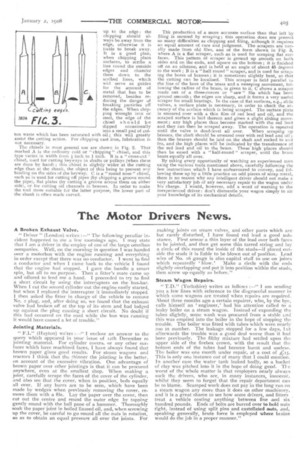The Motor Drivers News.
Page 17

If you've noticed an error in this article please click here to report it so we can fix it.
A Broken Exhaust Valve.
" Driver " (London) writes :—" The following peculiar incident happened to me a few mornings ago. I may state that I am a driver in the employ of one of the large omnibus companies. Well, on the morning in question I was handed over a motorbus with the engine running and everything in order except that there was no conductor. I went to find a conductor and when I came back to the vehicle I found that the engine had stopped. I gave the handle a smart spin, but all to no purpose. Then a fitter's mate came up and offered to lend me a hand. I proceeded to try to find a short circuit by using the interrupters on the bus-bar. When I cut the second cylinder out the engine easily started, but when I replaced the interrupter it immediately stopped. I then asked the fitter in charge of the vehicle to remove No. 2 plug, and, after doing so, we found that the exhaust valve had broken off at the top of its stern and had lodged up against the plug causing a short circuit. No doubt if this had occurred on the road while the bus was running it would have caused a lot of trouble."
Jointing Materials. "
FL" (Huyton) writes :—" I enclose an answer to the query which appeared in your issue of 12th December re jointing material. For cylinder covers, or any other surfaces which have machined faces, I have always found that brown paper gives good results. For steam wagons and tractors I think that the thinner the jointing is the better, on account of the excessive vibration. One advantage of brown paper over other jointing-s is that it can he procured anywhere, even at the smallest shop. When making a joint, carefully scrape the faces of the cover of the cylinder, and also see that the cover, when in position, beds equally all over. If any burrs are to be seen, which have been made by wedges when previously removing the cover, remove them with a file. Lay the paper over the cover, then cut out the centre and round the outer edge by tapping gently round with the ball pane of a hammer. Thoroughly soak the paper joint in boiled linseed oil, and, when screwing up the cover, be careful to go round all the nuts in rotation, so as to obtain an equal pressure all over the joints. For making joints on steam valves, and other parts which are but rarely disturbed, I have found red lead a good substance. First smear a thin layer of the lead over both faces to be jointed, and then get some thin tarred string and lay a circle of this round the inside of the studs—if placed outside the studs it is liable to be blown out of position. Lead wire of No. 16 gauge is also capital stuff to use on joints
which repeatedly blow.' Make a circle with the ends slightly overlapping and put it into position within the studs, then screw up equally as before."
Steam Wagon Repairs.
" T.D." (Yorkshire) writes as follows :—" I am sending you a few lines with reference to the disgraceful manner in which some wagons are treated when repairs are required. About three months ago a certain repairer, who, by the bye, calls himself an engineer,' had his attention called to a leaky boiler on a steam wagon. Instead of expanding the tubes slightly, some wash was procured from a stable .&nd this was emptied into the boiler in the hope of stopping the trouble, The boiler was fitted with tubes which were nearly 200 in number. The leakage stopped for a few days, t ut afterwards the trouble was a good deal worse than it had been previously. The filthy mixture had settled upon the upper side of the firebox crown, with the result that the bottom ends of the tubes had become burnt and useless. The boiler was one month under repair, at a cost of This is only one instance out of many that I could mention. In another case the water tank leaked badly, so a bucket of clay was pitched into it in the hope of doing good. TI-e worst of the whole matter is that employers nearly always sack the drivers, who are in many instances, innocent, whilst they seem to forget that the repair department can be to blame. Scampecl work does not pay in the long Tun on a steam wagon any more than it does on other machinery, and it is a great shame to see how some drivers, and fitters treat a vehicle costing anything between five and six hundred pounds. Ends of bolts are burred over to bold nuts tight, instead of using split pins and castellated outs, and, speaking generally, brute force is employed where btains would do the job in a proper manner."


















